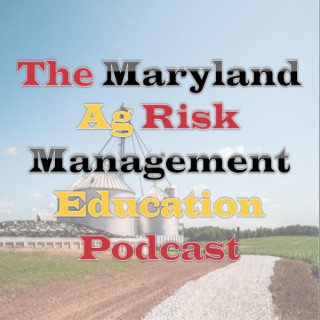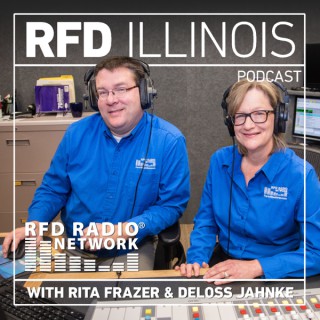Podcasts about usda risk management agency
- 14PODCASTS
- 17EPISODES
- 18mAVG DURATION
- ?INFREQUENT EPISODES
- Feb 25, 2025LATEST
POPULARITY
Best podcasts about usda risk management agency
Latest podcast episodes about usda risk management agency
Paul Kanning is a farmer in Montana who grows mostly red lentils and yellow peas as well as wheat and canola. He also serves as the chairman of the USA Dry Pea and Lentil Council. Lewi Crow is a Risk Management Specialist with the USDA Risk Management Agency that services Wyoming, Montana and the Dakotas. Lewi and Paul talk about the importance of RMA and crop insurance, but also the process behind developing crop insurance programs for pulse crops. “ As an individual farmer, I have to provide them data and the way I do that is by making transactions, right? And so selling pulses in the fall helps establish the harvest price for the fall. That's the only way that they can come up with the data is by farmers putting product out in the stream… That makes the whole wheel turn.” - Paul Kanning ”...some of the things that I do with that is reviewing plant dates, basically just kind of pulling apart crop programs and reviewing all aspects of it that goes on with rates and t-yields for individual counties, rotation requirements, various things that farmers tend to encounter when choosing crop insurance.” - Lewi CrowThis Week on Growing Pulse Crops:Meet Paul Kanning, a pulse crop farmer in Montana and the chairman of the USA Dry Pea and Lentil Council, and Lewi Crow, a Risk Management Specialist with the USDA Risk Management Agency Understand what the RMA provides for producers and the insight they can offer when making production decisionsMake a note of these important dates:January 15th is when the harvest price is released Beginning of March is when projected prices for this 2025 crop year are releasedMarch 15th is the sales closing date for most of the spring seeded crops so Lewi recommends reviewing your crop insurance prior to that date Growing Pulse Crops is produced by Dr. Audrey Kalil and hosted by Tim Hammerich of the Future of Agriculture Podcast.
Brian Frieden Discusses Upcoming USDA Risk Management Workshop
February 13th, the USDA Risk Management Agency is hosting a Livestock Risk Management workshop at the Knox County Farm Bureau. Brian Frieden shares more about the workshop.
Episode 132 – Insurance Options for Livestock Producers
Cody McCann and Cody Lovercamp both work for the USDA Risk Management Agency where they oversee the policy language for the livestock policies and the underwriting standards branch. McCann and Lovercamp discuss topics like, what is Livestock Risk Protection? How does it work? When can you, as a producer, receive these options. To learn more […]
USDA Livestock Risk and Specialty Crops Programs For Price Declines
Marcia Bunger, Risk Management Agency Administrator for USDA talks about popular programs for US producers.
12-01-22 - Erick visits with Marcia Bunger of USDA Risk Management Agency.
Inside Agriculture Segment 2
AoR 94: Current Cattle Market Risks & Opportunities with Shannon Neibergs and Jack Field
The global nature of agricultural trade and market forces makes cattle price cycles less predictable, and this presents a different kind of risk than historical pricing pressures. But Dr. Shannon Neibergs, director of the Western Center for Risk Management and a livestock economist, believes there are real opportunities to respond to (in winter 2022-23). Listen in to learn about the current milieu. We conclude with Jack Field (CKP Insurance) on how Livestock Risk Protection can help you mitigate market volatility. RESOURCES Livestock Risk Protection for Feeder Cattle, USDA Risk Management Agency fact sheet, https://www.rma.usda.gov/Fact-Sheets/National-Fact-Sheets/Livestock-Risk-Protection-Feeder-Cattle Episode 66 on LRP, https://artofrange.com/episodes/aor-66-livestock-price-risk-management-jack-field-shannon-neibergs TRANSCRIPT COMING SOON AT https://artofrange.com/episodes/aor-94-current-cattle-market-risks-opportunities-shannon-neibergs-and-jack-field
Annual Forage Insurance Offers Risk Protection Amid Dry Conditions with Jay Parsons
With recent drought conditions across Nebraska, concerns about the availability of forage for cattle this grazing season are top of mind for many producers. While planting forage can have numerous benefits, there is also a certain amount of risk that comes with uncertainty about precipitation and soil moisture. The Annual Forage Insurance Plan from the USDA Risk Management Agency is a program that can help crop and livestock producers mitigate these precipitation risks when growing annual forages. The signup deadline for coverage during the next year is July 15 and, for more about the program, we hear from Jay Parsons, professor and farm and ranch management specialist with the Center for Agricultural Profitability at UNL. Read more at https://cap.unl.edu/forage/insurance-annual-forages-sign-deadline-july-15.
In this episode, I visit with Craig Christianson, Risk Management Specialist with the USDA Risk Management Agency, about Whole Farm Revenue Protection.
Afternoon Ag News, September 13, 2021: Farmers applying split nitrogen will have a new option for insurance coverage
Corn farmers who “split apply” nitrogen will soon have another option for insurance coverage. Beginning in crop year 2022, the USDA Risk Management Agency will offer the Post Application Coverage Endorsement (PACE) in certain states for non-irrigated corn, providing coverage for producers who use this practice that is considered better for natural resources and saves money for producers. See omnystudio.com/listener for privacy information.
AoR 66: Livestock Price Risk Management with Jack Field & Shannon Neibergs
The future ain't what it used to be (Yogi Berra): there are more price risks and stressors on cattle markets than ever, and the predictability of cattle markets is at an all-time low. Livestock insurance is not new but is recently gaining adoption as a reliable risk tool to prevent catastrophic financial losses and prepare for uncertainties such as drought. Listen to Jack Field, with CKP Insurance, discuss insurance products with Dr. Shannon Neibergs, WSU livestock economist and director for the Western Center for Risk Management Education. For more information, contact Jack directly at jfield@ckpinsurance.com or (509) 929-1711 . Transcript: https://bit.ly/3x5mbIC More information from USDA Risk Management Agency on LRP is available at https://www.rma.usda.gov/Policy-and-Procedure/Insurance-Plans/Livestock-Insurance-Plans.
Mid-Morning Ag News, July 16, 2021: USDA RMA to establish separate enterprise units for spring wheat and durum wheat
The United States Durum Growers Association and North Dakota Grain Growers Association applaud the decision by the USDA Risk Management Agency to establish separate enterprise units for spring wheat and durum wheat in the federal crop insurance program. See omnystudio.com/listener for privacy information.
Conversation with Illinois Farm Bureau Vice President Brian Duncan on the July IFB Resolutions Committee meeting. They discussed the process and the issues surrounding submittals from county farm bureaus. Bob Young, Economist with Agricultural Prospects, talks about the prospect of Inflation. In news, Matt Kaye talks about slim prospects for legislative action on reversal of the court ruling regarding summer use of E15. The USDA Risk Management Agency will no longer consider cover crops as a 2nd crop when hayed, chopped, or grazed when handling prevent plant claims.
Southern Plains Podcast #44-Francie Tolle, USDA Risk Management Agency
In this episode of the podcast we visit with Francie Tolle, Director of the Product Administration and Standards Division with the USDA Risk Management Agency (RMA) in Kansas City, Missouri. Francie visits with us about the role RMA plays in helping producers manage risk (including the risk caused by extreme weather events), the new Pandemic Cover Crop Program (PCCP) and why its important that soil health producers report their cover crops to FSA.
Beltway Beef Podcast: SCOTUS Confirmation Process And PRF Comment Period Opens
In this week's episode, NCBA's Environmental Counsel, Mary-Thomas Hart and NCBA’s Executive Director Of Government Affairs, Allison Rivera discuss the Supreme Court confirmation process and the United States Department of Agriculture (USDA) Risk Management Agency's Pasture, Rangeland, and Forage (PRF) pilot program.
Court of Appeals Agrees USDA Did Not Have the Discretion to Implement New Program Benefiting Farmers
In this episode, Paul provides an update on a case involving Colorado winter wheat producers who requested actual production history yield exclusion in 2015 but the USDA Risk Management Agency denied the request. The case highlights when USDA potentially has to make new programs available to producers. Materials discussed in this episode: Ausmus v. Perdue, 289 F.Supp.3d 1227 (D. Colo. 2018) Ausmus v. Perdue, 908 F.3d 1248 (10th Cir. 2018). Goeringer, Paul, Court of Appeals Agrees USDA Did Not Have the Discretion to Implement New Program Benefiting Farmers (AREC, March 19, 2019). Goeringer, Paul, Updated: Quick Look at Yield Exclusion Option in 2014 Farm Bill (AREC, July 13, 2015). Goeringer, Paul, USDA Did Not Have Discretion to Implement New Program Benefitting Farmers: When Does the Agency Have Discretion to Implement a New Program? (AREC, July 12, 2018). If you have questions for Paul contact him at lgoering@umd.edu, tweet him @aglawPaul or 301-405-3541.
USDA Did Not Have Discretion to Implement New Program Benefitting Farmers: When Does the Agency Have Discretion to Implement a New Program?
In this episode, Paul discusses a recent decision out of Colorado involving winter wheat producers who requested actual production history yield exclusion in 2015 but USDA Risk Management Agency denied the request. The case highlights when USDA potentially has to make new programs available to producers. Materials discussed in this episode: Ausmus v. Perdue, 289 F.Supp.3d 1227 (D. Colo. 2018) Goeringer, Paul, Updated: Quick Look at Yield Exclusion Option in 2014 Farm Bill (AREC, July 13, 2015). Goeringer, Paul, USDA Did Not Have Discretion to Implement New Program Benefitting Farmers: When Does the Agency Have Discretion to Implement a New Program? (AREC, July 12, 2018). If you have questions for Paul contact him at lgoering@umd.edu, tweet him @aglawPaul or 301-405-3541.
I'm excited to have Dr. Jason Johnson, a District Economist for Texas A&M Agrilife Extension on the show today to talk about Pasture, Rangeland, and Forage Insurance, more commonly referred to as rainfall insurance. As Dr. Johnson explains, this is an insurance product through the USDA Risk Management Agency that allows a producer to essentially insure average rainfall for his or her area, and receive an indemnity payment if no rainfall occurs. This episode will provide an overview of the program and walks you through the four decisions that must be made in order to enroll. We also talk about how to sign up, including the deadline to do so, who you can purchase through, and how the RMA shares in the premium cost. Contact Info for Dr. Jason Johnson (Phone) (254) 968-4144 (Email) jljohnson@tamu.edu (Website) http://agecon.tamu.edu/faculty-staff/faculty/johnson-jason/ Links to Information Mentioned on the Show RMA Pasture, Rangeland and Forage website RMA Decision Tool and Grid Locator RMA Pasture Range Forage Frequently Asked Questions

















